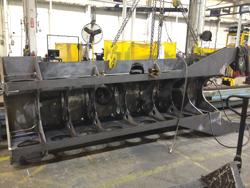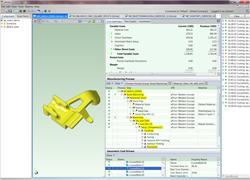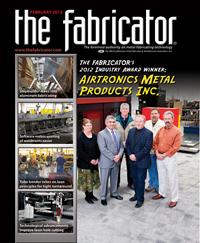Editor-in-Chief
- FMA
- The Fabricator
- FABTECH
- Canadian Metalworking
Categories
- Additive Manufacturing
- Aluminum Welding
- Arc Welding
- Assembly and Joining
- Automation and Robotics
- Bending and Forming
- Consumables
- Cutting and Weld Prep
- Electric Vehicles
- En Español
- Finishing
- Hydroforming
- Laser Cutting
- Laser Welding
- Machining
- Manufacturing Software
- Materials Handling
- Metals/Materials
- Oxyfuel Cutting
- Plasma Cutting
- Power Tools
- Punching and Other Holemaking
- Roll Forming
- Safety
- Sawing
- Shearing
- Shop Management
- Testing and Measuring
- Tube and Pipe Fabrication
- Tube and Pipe Production
- Waterjet Cutting
Industry Directory
Webcasts
Podcasts
FAB 40
Advertise
Subscribe
Account Login
Search
First in, first to win
Software helps Steel Fabrication get accurate quotes to customer sooner rather than later
- By Dan Davis
- February 3, 2012
- Article
- Shop Management

Steel Fabrication Inc. has made a name for itself when it comes to manufacturing huge weldments, such as this oil pan for locomotive engines. It has press brake capability up to 28 feet, stamping presses up to 2,000 tons, and a five-axis machining center to handle a 40-ton part.
In today’s just-in-time world, orders for metal parts aren’t the only thing that customers want turned around as quickly as possible. Those requests for quotes (RFQs) need to be completed ASAP.
If the order is for a few hundred right-angle metal components that just need some laser cutting and press brake time, the estimator isn’t going to struggle to kick out that RFQ in a day or so. But what happens if the quote is for a huge weldment that might entail up to 200 separate blueprints? The quoting job has to be split up among a team of estimators, who individually have to calculate—manually, in most instances—rates for welding and secondary processes. Such a large task could tie up an estimating team for days.
That’s where Steel Fabrication Inc. (SFI), a designer and fabricator of medium- to heavy-gauge metal components, found itself more than two years ago. The delays in getting quotes to customers in a timely manner were a concern. Pretty much all estimating was done manually, using home-grown cost calculators and spreadsheets and off-the-shelf cost management tools. Because of the time involved putting together even the simplest job costs, SFI’s estimators often felt they were always behind schedule, leading them to postpone quoting some jobs as they caught up on other work, or not quoting some jobs at all simply because they couldn’t get to it by the requested deadlines.
That presented a real problem for SFI, which works with key OEMs in the agricultural, automotive, construction, industrial, transportation, and defense industries. The metal fabricator couldn’t expect to win a job if it couldn’t complete the RFQ for the OEM.
“You’ve got a guy on the other end who needs a price and has a budget, and if you can get in that budget and get it to him … that’s it,” said Hashim Alsaffar, SFI’s lead estimator. “First in, first to win.”
To win the race to that guy’s desk, SFI first had to figure out the best way to streamline its own quoting activities.
The Big Deal: Job Estimating Huge Weldments
At the very least, SFI knew it had to settle on one way to bring together all these sources of estimating knowledge. Of course, the company was hardly alone in its desire to tap the minds of its most veteran employees.
“I came from another metal fabricator before I came here and worked closely for a brief time with the management of the estimating department there,” said Chris Britt, SFI’s director of engineering. “A lot of the time, the estimates were done based on the tribal knowledge. Somebody’s been there for 40 years, and he’s an estimator and knows that they can run this at a particular rate or this at a certain speed. And in some cases, that tribal knowledge wasn’t correct. We would later have issues down the road.”
Such was the case for SFI when huge RFQs for huge weldments were received. Projects of that size could include 500 different parts, requiring estimators to analyze a series of 2-D drawings, from which they would identify different production attributes and then determine run rates and labor costs. Sometimes it took weeks for them to turn around the quote. Add to that the fact that if the customer provided 3-D models, SFI estimators had to turn them into 2-D prints before embarking on their own focused investigations of production details. That extended the quoting time frame unnecessarily.
SFI sought to improve its quoting methods in early 2010 with the implementation of aPriori product cost management software. aPriori had spent the previous seven years building a reputation as a useful tool for manufacturing OEMs to reduce costs related to product launches. The procurement professionals for these OEMs used the software to receive real-time production cost information for outsourced products, ensuring they were always getting an optimal price. Design engineers relied on the software to provide new cost projections when design changes occurred, helping to keep projects under budget.

With the use of its cost estimating software, SFI estimators can determine production costs for complex fabrications in hours instead of days. The software also allows estimators to make changes, such as material substitutions, and get a side-by-side comparison of costs.
SFI was aPriori’s first customer that provided metal fabricating services as a supplier. The software developer spent about a year working with the fabricator to fine-tune the software, nailing down the correct rates for all production activities and adjusting the algorithms to ensure SFI got the results it desired.
Production Quotes in Minutes
Alsaffar started work at SFI in late 2010 and jumped right into using the estimating software. He admitted he wasn’t sure what to think at the start, but he was confident because most of his engineering experience had been with 3-D CAD models, which made the whole process work.
More than a year into using the software, he said the tool is a key competitive advantage for SFI.
“We can respond more quickly to customer requests for quotes, respond to more requests overall, and equally important, see immediately whether or not a job is really in our sweet spot,” Alsaffar said.
As an example, Alsaffar mentioned the company’s fabricating specialty—very large weldments. He and the company’s other three estimators can bring up a 3-D model from almost any major CAD software, click on a joint, and apply a weld to it. The software applies an orange line to the joint area where the weld will be placed. Simultaneously it will produce fixture costs and weld rates.
“It’ll also come up with inches of welds, which is huge,” Alsaffar said. Without the help of the software, an estimator has to keep a running tally of weld inches, often having to refer back to prints just to check that the correct number of inches has been logged.
“With aPriori, you have visual cues, and you know if you’ve caught all of the welding. That’s where a lot of time can be eaten up on a quote,” he said.
The software also gives estimators an idea whether the part will need to be reoriented during welding and if such a job will require additional hands or even a crane.
Britt suggested that the cost estimating software be put to the test with one of SFI’s more labor-intensive jobs—an oil pan for a locomotive engine (see Figure 1). A veteran welding expert was given the files, and he deconstructed the part into prints and determined the total number of inches and the subsequent weld rate. After about the equivalent of two days, he calculated 36 hours of welding to fabricate the entire part. The software took the design files and calculated a total fabrication time of 38 hours in just two hours’ time. Alsaffar called the difference “pretty negligible for something that massive.”
Additional Uses for the Software
Alsaffar added that SFI is also using the software to derive “best costs” (see Figure 2) for its fabricating activities. When a part has been fully estimated, the estimator then can compare fabrication costs for the company’s three plants in Conway, Ark.; Memphis; and New Boston, Ohio. Some manufacturing costs may be totally out of line because the facility doesn’t have specific fabrication capabilities, or one manufacturing plant may stand out because it has excess capacity on its machines.
“With the programs and the tools we’ve got, it’s made things a lot simpler,” Britt said of the software. “We can get a lot of quotes and products through the system. And our accuracy has improved tremendously too.”
SFI just completed an update of the aPriori software. Alsaffar said estimators now can customize the software much more easily. They can access a toolbox to add a new machine, if a new press brake is installed at one of the company’s locations, for instance. The update also allows the material library to be expanded with additional information such as material densities and tensile strengths.
All are helpful advantages in the race to get quotes in the inbox as fast as possible.
About the Author

Dan Davis
2135 Point Blvd.
Elgin, IL 60123
815-227-8281
Dan Davis is editor-in-chief of The Fabricator, the industry's most widely circulated metal fabricating magazine, and its sister publications, The Tube & Pipe Journal and The Welder. He has been with the publications since April 2002.
subscribe now

The Fabricator is North America's leading magazine for the metal forming and fabricating industry. The magazine delivers the news, technical articles, and case histories that enable fabricators to do their jobs more efficiently. The Fabricator has served the industry since 1970.
start your free subscription- Stay connected from anywhere

Easily access valuable industry resources now with full access to the digital edition of The Fabricator.

Easily access valuable industry resources now with full access to the digital edition of The Welder.

Easily access valuable industry resources now with full access to the digital edition of The Tube and Pipe Journal.
- Podcasting
- Podcast:
- The Fabricator Podcast
- Published:
- 04/16/2024
- Running Time:
- 63:29
In this episode of The Fabricator Podcast, Caleb Chamberlain, co-founder and CEO of OSH Cut, discusses his company’s...
- Trending Articles
AI, machine learning, and the future of metal fabrication

Employee ownership: The best way to ensure engagement

Dynamic Metal blossoms with each passing year

Steel industry reacts to Nucor’s new weekly published HRC price

Metal fabrication management: A guide for new supervisors

- Industry Events
16th Annual Safety Conference
- April 30 - May 1, 2024
- Elgin,
Pipe and Tube Conference
- May 21 - 22, 2024
- Omaha, NE
World-Class Roll Forming Workshop
- June 5 - 6, 2024
- Louisville, KY
Advanced Laser Application Workshop
- June 25 - 27, 2024
- Novi, MI


























